When Heather at Healthy Family Cookin' shared her post Frugal Friday: The Hidden Costs last week on Frugal Friday, I immediately thought of Shelf Reliance. Heather points out 3 hidden costs to things we buy: travel costs, maintenance costs and storage costs. She applies these hidden costs to clothes, toys, vehicles and homes. I want to apply them to food.
Travel costs - you have to travel to the grocery store to buy food from them, whether you are buying at a local store, a warehouse store, or discount store. And don't forget the time you spend doing this.
Maintenance costs - Iwas thinking this one is primarily a cost of time for dealing with the food so that you eat it before it goes bad. This would include putting food in freezer containers, and chopping fruits and vegetables into serving sizes. And then I realized I have to maintain my refrigerator and freezer to maintain the foods I keep in them.
Storage costs - have you ever thought about the electricity costs to keep your food in the refrigerator or freezer? What about the costs of the storage bags, or the plastic containers to keep them in until you're ready to prepare and eat the food?
THRIVE Foods can minimize some of these costs.
Storage - Since the storage container is part of the product, the cost of the storage container is included in the price of the food. Because THRIVE foods are freeze dried or dehydrated, they do not need to be refrigerated or frozen to maintain their optimal shelf life (exception would be reconstituted foods, especially the dairy products).
Maintenance - THRIVE foods are rinse, chopped (if needed), and ready to use, many times even without rehydrating. Again, THRIVE foods (except if storing after reconstituting) do not need the refrigerator or freezer so less maintenance costs there.
Travel - Although you spend money on shipping, you do not have other travel costs and the time associated with grocery shopping for THRIVE Foods. THRIVE Foods are shipped directly to your home via FedEx so no travel costs or time involved.
Before Shelf Reliance, I had never considered adding in the cost of using my freezer to the cost of the food that I buy and store in it. Although I had considered the costs of replacing the foods if the power went out long enough that the food went bad in my freezer.
I'm sharing this post with Frugal Friday on Life As Mom. Check out the other frugal tips shared today!

![I'm THRIV[E]-ing](https://blogger.googleusercontent.com/img/b/R29vZ2xl/AVvXsEh1qmqosaawYjPYTMmcKvDH9wKOO4mEQalcgEM-eSUXQOZMCi-B_-ox8kjfYOvO83nEG1_3dybIhC3sDQibDrnSVd6i1ETV5xhzEem6x506H9uUKoyvFLfolS_iNLR8bvfs-thncRpfMg0U/s1600/Blog+Header+with+thrive-foods.jpg)

Those are interesting points. I don't really want to think about what I spend on Ziplock bags alone (although I do use them for lots more than food storage).
ReplyDeleteThanks for coming over for a visit Jean! Even though I wrote the post, I'm still not wanting to think about it. And one I didn't mention was the cost of throwing away what you didn't eat before it spoiled.
DeleteInteresting application of these principles to food. I would love to see a cost analysis of this to see if freeze dried foods really do cost less in the long run. It does seem like with freeze dried foods you would be paying more per pound up front due to the processing of the foods to get them to the freeze-dried state. But you have some good points about the less hassle (travel, time), less waste, less storage space (because they are lighter in weight and smaller in size). But do you have to store more water because of this? Is that a hidden cost of freeze dried foods? Also there still would be the storage rotation system included in the hidden costs also. Anyway, just some points to consider. Thanks for joining in the conversation about it. It's certainly an interesting discussion.
ReplyDelete